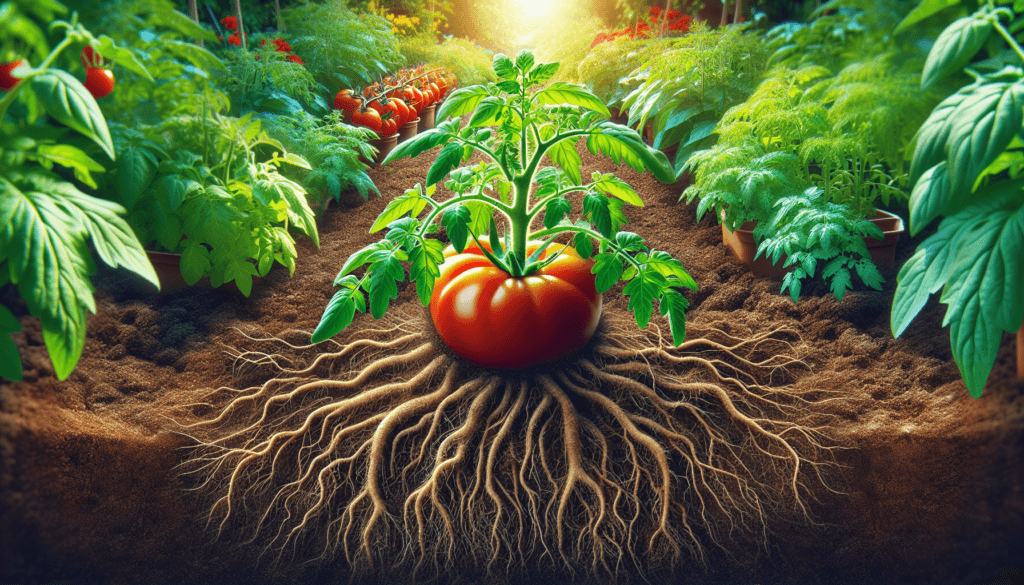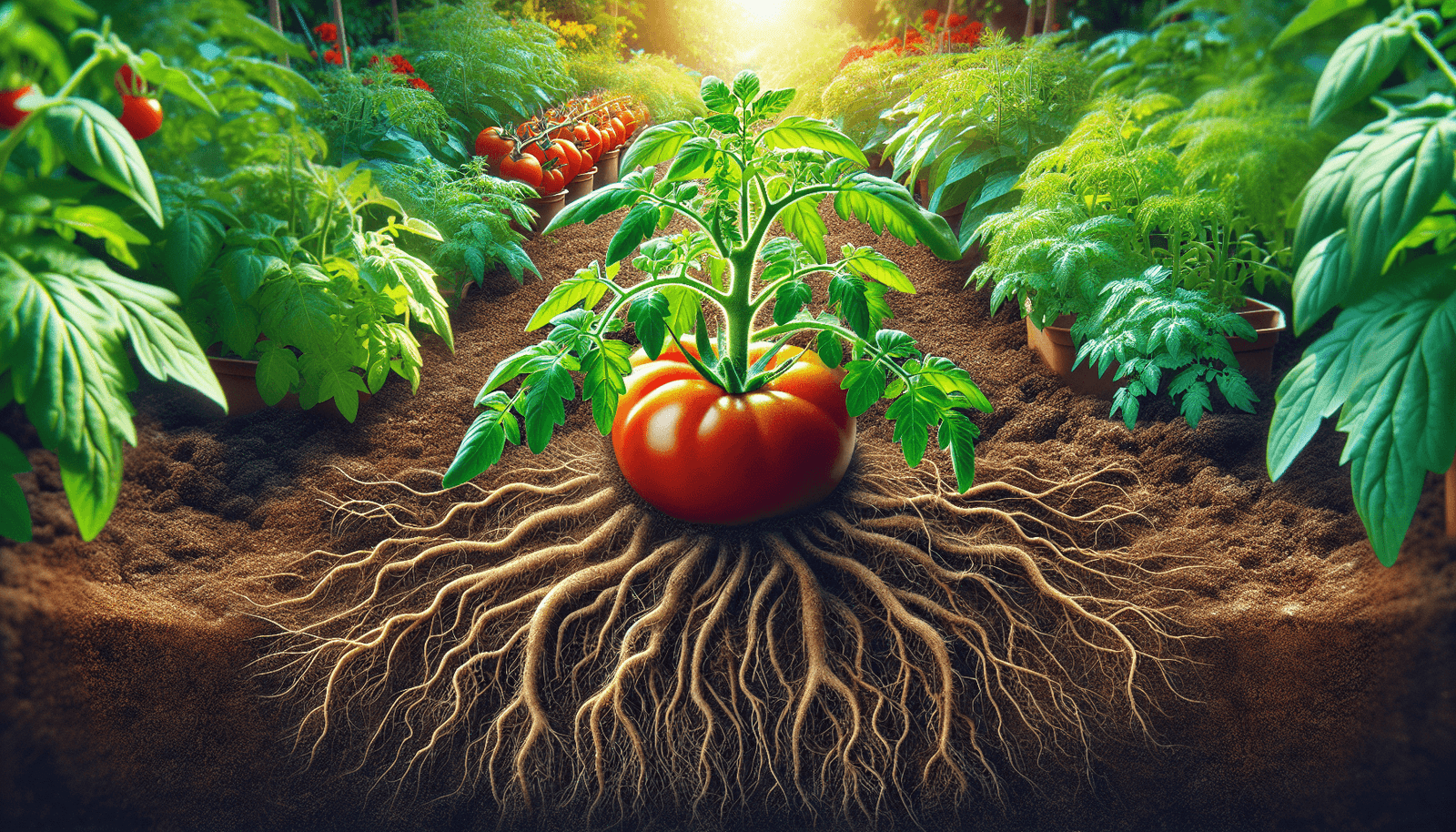Are you looking to create a thriving garden that is not only beautiful but also environmentally friendly? If so, then you’re in luck! In this article, we will explore the top 10 eco-friendly ways to improve soil health in your garden. By utilizing these simple yet effective methods, you can ensure that your soil remains nutrient-rich, promotes plant growth, and supports a healthy ecosystem. From composting to utilizing cover crops, we’ve got you covered with all the tips and tricks you need to create a thriving and sustainable garden. So grab your gardening gloves and get ready to transform your garden into a green paradise!

1. Composting
Benefits of composting
Composting is a natural and eco-friendly way to improve soil health in your garden. By composting, you are reducing waste and providing nutrient-rich organic matter to your soil. Compost helps to improve soil structure, retain moisture, and increase nutrient availability for plants. It also enhances microbial activity in the soil, promoting a healthy and balanced ecosystem. Additionally, composting reduces the need for chemical fertilizers and helps to reduce greenhouse gas emissions.
How to start composting
Starting a compost pile is easy and requires minimal effort. Begin by selecting a suitable location for your compost pile or bin. It should be in a well-drained area and easily accessible. Next, gather a mix of brown and green materials. Brown materials include dry leaves, straw, and shredded newspaper, while green materials consist of grass clippings, fruit and vegetable scraps, and coffee grounds. Layer these materials, making sure to alternate between brown and green, to create a balanced carbon-to-nitrogen ratio. Keep the compost pile moist and turn it regularly to accelerate the decomposition process. With time and proper maintenance, you’ll have rich, dark compost to enhance your garden’s soil health.
What materials to compost
A wide variety of materials can be composted to create nutrient-rich soil amendment. Green materials such as fruit and vegetable scraps, coffee grounds, tea leaves, grass clippings, and plant trimmings are rich in nitrogen and provide essential nutrients for your plants. Brown materials like dry leaves, straw, shredded newspaper, and wood chips provide carbon and help create a balanced compost mixture. Other items that can be composted include eggshells, cardboard, and even small amounts of yard waste. However, it is important to avoid composting meat, dairy products, oily foods, and pet waste as they can attract pests and cause odor problems.
Tips for successful composting
To ensure successful composting, follow these tips:
- Maintain a balanced carbon-to-nitrogen ratio by layering brown and green materials.
- Keep the compost pile moist, but not wet, to help with decomposition.
- Turn the compost pile regularly to provide oxygen for the microbial activity.
- Chop or shred larger materials to help speed up the composting process.
- Avoid adding diseased plants, weed seeds, or invasive species to your compost pile.
- Consider using a compost thermometer to monitor the temperature of your compost pile. Optimum temperature for decomposition is between 120-160°F (49-71°C).
- If you have limited space or want to avoid pests, consider using a compost bin or tumbler.
2. Mulching
Types of mulch
Mulching is another eco-friendly technique to improve soil health in your garden. There are various types of mulch that can be used, depending on your gardening needs. Organic mulches, such as straw, wood chips, shredded leaves, and grass clippings, decompose over time, adding organic matter to the soil. Inorganic mulches, such as plastic or landscape fabric, do not decompose, but they help conserve moisture and suppress weed growth. Both types of mulch have their benefits and can be used in different garden areas.
Benefits of mulching
Mulching provides numerous benefits to your garden soil. It helps to regulate soil temperature, keeping it cooler in the summer and warmer in the winter. Mulch also helps to conserve moisture by reducing evaporation, which is especially beneficial during hot and dry periods. Additionally, mulch acts as a natural weed barrier, suppressing weed growth and reducing the need for manual weeding. Furthermore, mulch helps to prevent soil erosion and protects plant roots from extreme temperatures and damage.
How to mulch effectively
To mulch effectively, start by removing any existing weeds and debris from the area to be mulched. Apply a layer of mulch around your plants, leaving a small gap around the plant stem to prevent moisture buildup and potential rot. The depth of the mulch layer should be around 2-4 inches, depending on the type of mulch and the desired coverage. Make sure not to pile mulch up against the plant stem as it can cause disease and rot. Lastly, replenish mulch as needed to maintain an adequate layer throughout the growing season.
Best practices for mulching
To make the most of mulching, consider the following best practices:
- Mulch at the right time, such as in the spring or fall, when the soil is moist and temperatures are mild.
- Avoid using thick layers of mulch, as it can create a barrier that prevents water and air from reaching the soil.
- Use organic mulches in vegetable gardens or areas where frequent soil amendments are required, as they break down over time and contribute to soil fertility.
- Inorganic mulches like plastic or landscape fabric work best for perennial beds or areas where weed suppression is the primary concern.
- Regularly inspect the mulch layer for signs of mold, pest infestation, or weed growth and address any issues promptly.
- Consider using mulch alternatives like gravel or stones for pathways or areas with high foot traffic where traditional mulches may be easily displaced.
3. Cover Cropping
Understanding cover crops
Cover cropping, also known as green manure, is a practice in which specific plants are grown to improve soil health and fertility. Cover crops are usually sown during the off-season or in unused areas of the garden. They help protect the soil from erosion, suppress weeds, improve water infiltration, and enhance nutrient cycling. When the cover crops are tilled into the soil, they break down and add organic matter, enriching the soil and improving its structure.
Benefits of cover cropping
Cover cropping offers numerous benefits to your garden’s soil health. Firstly, cover crops help to prevent soil erosion by covering the soil surface and holding it in place during heavy rains or wind. This is particularly important on sloped areas or in regions prone to erosion. Secondly, cover crops suppress weeds by outcompeting them for space, light, and nutrients. By reducing weed competition, cover crops help ensure that your garden plants have access to resources necessary for their growth. Additionally, cover crops improve soil fertility by fixing atmospheric nitrogen, adding organic matter, and increasing microbial activity in the soil. This leads to improved nutrient availability for future crops and enhances the overall health and productivity of the soil ecosystem.
Choosing the right cover crops
When selecting cover crops, consider the specific needs of your garden and the goals you want to achieve. Leguminous cover crops like clover, peas, or beans are excellent choices for nitrogen fixation, as they have the unique ability to convert atmospheric nitrogen into a form plants can utilize. Brassicas, such as mustard or radishes, are beneficial for their biofumigation properties, which help suppress soil-borne pests and diseases. Other cover crops like oats or rye can provide ground cover, protect against erosion, and add organic matter to the soil. Consider rotating cover crops to maximize their benefits and avoid potential pest or disease buildup.
How to plant and manage cover crops
Before planting cover crops, prepare the soil by removing weeds and debris and loosening the top layer. Broadcast the cover crop seeds evenly over the area, following the recommended seeding rate for the specific cover crop. Rake or lightly till the soil to ensure good seed-to-soil contact. Water the area thoroughly and keep it moist until the cover crops are established. Some cover crops may require additional watering during dry periods. In the spring, when the cover crops have reached their peak growth, mow or cut them down to ground level. Allow the cut vegetation to dry for a few days, then till it into the soil. This process releases the nutrients, adds organic matter, and prepares the bed for planting your desired crops.
4. Crop Rotation
Importance of crop rotation
Crop rotation is a vital practice that helps maintain soil health and minimize the risk of pests, diseases, and nutrient deficiencies. By rotating crops, you disrupt the life cycles of pests and diseases, reducing the buildup of harmful organisms in the soil. Different crops have different nutrient requirements, and rotating crops prevents excessive nutrient depletion and imbalances in the soil. Moreover, certain plants are known to enhance soil fertility or suppress pests, and incorporating them into your crop rotation plan can have significant benefits for overall soil health.
How to implement crop rotation
To implement crop rotation, divide your vegetable garden into different sections or beds. Assign each section a specific crop group based on their botanical relationships and nutrient requirements. Common crop groups include brassicas (e.g., cabbage, broccoli), legumes (e.g., beans, peas), root vegetables (e.g., carrots, onions), and solanaceous crops (e.g., tomatoes, peppers). Rotate the crop groups between sections each year, preferably following a three-to-four-year rotation cycle. This allows time for the soil to recover and reduces the risk of disease recurrence and nutrient imbalances. Keep a record of your crop rotation plan to ensure you maintain the proper sequence and avoid repeating the same crop in the same location too frequently.
Crop rotation schedules
The specific crop rotation schedule will depend on various factors, including the size of your garden, the number of beds available, and the specific crops you grow. However, a general crop rotation plan to follow, using a four-bed rotation system, could be as follows:
Year 1: Brassicas Year 2: Legumes Year 3: Root vegetables Year 4: Solanaceous crops
You can adjust the crop rotation plan based on your specific needs and the crops you want to grow. The key is to ensure that each crop group follows a different crop to maximize soil health benefits and minimize pest and disease issues.
Tips for successful crop rotation
To ensure successful crop rotation, keep these tips in mind:
- Plan your crop rotation schedule in advance and keep a written record to help you remember the sequence.
- Practice good garden hygiene by removing plant residue, weeds, and crop debris to reduce the risk of disease and pest carryover.
- Rotate crops within the same family, rather than simply changing the variety. This helps to disrupt pest and disease cycles more effectively.
- Incorporate cover crops into your rotation plan to enhance soil fertility and disrupt pest life cycles.
- Consider interplanting or companion planting to optimize space and provide additional benefits such as pest control or nutrient sharing between plants.
- Monitor your crops closely for signs of pests or diseases and take appropriate action to prevent their spread.
- Regularly test your soil to identify any nutrient deficiencies or imbalances and adjust your crop rotation plan accordingly.

5. Organic Fertilizers
Advantages of organic fertilizers
Using organic fertilizers is an eco-friendly way to nourish your garden soil and promote plant growth. Organic fertilizers are derived from natural sources, such as compost, manure, bone meal, and seaweed. Unlike synthetic fertilizers, organic fertilizers release nutrients slowly, ensuring a more sustained and balanced nutrient supply for plants. They also contribute to overall soil health by improving soil structure, enhancing microbial activity, and increasing nutrient retention. Furthermore, organic fertilizers are less likely to burn plants or leach into groundwater, making them a safer choice for the environment.
Choosing the right organic fertilizers
When choosing organic fertilizers, consider the specific nutrient requirements of your plants and the needs of your soil. Compost, for example, is a fantastic all-around fertilizer that provides a balanced mix of nutrients and organic matter. Manure, whether from cows, horses, or chickens, is rich in nitrogen, phosphorus, and potassium, making it suitable for crops with high nutrient demands. Bone meal is a good source of phosphorus, while seaweed and kelp meal provide trace minerals and growth-promoting hormones. Other organic fertilizers, such as fish emulsion or blood meal, offer specific nutrients for targeted plant needs. Consider conducting a soil test to identify any nutrient deficiencies or imbalances and select organic fertilizers accordingly.
How to apply organic fertilizers
To apply organic fertilizers, start by preparing the soil surface by removing weeds, debris, and any surface crust. Spread the organic fertilizer evenly over the desired area, avoiding direct contact with the plant stems. Follow the recommended application rates provided on the fertilizer packaging, as over-application can lead to nutrient imbalances or burn plants. After applying the organic fertilizer, gently work it into the top layer of soil using a rake or garden fork. Water the area thoroughly to activate the release of nutrients and help them reach the plant roots. For best results, apply organic fertilizers in the spring before planting or as a side dressing during the growing season.
Common organic fertilizers and their uses
-
Compost: Compost is a versatile organic fertilizer made from decomposed organic matter. It provides a balanced mix of nutrients and improves soil structure. Use compost as a general soil amendment or as a top dressing around plants throughout the growing season.
-
Manure: Animal manure, such as cow, horse, or chicken manure, is rich in nutrients and acts as a slow-release organic fertilizer. It is especially beneficial for crops with high nutrient demands, such as tomatoes or corn. Ensure that manure is aged or composted before using it to avoid burning plants and to reduce the risk of bacterial contamination.
-
Bone meal: Bone meal is a source of phosphorus, an essential nutrient for root development and flowering. It is particularly useful for flowering plants and bulbs. Incorporate bone meal into the soil when preparing the planting area or sprinkle it around established plants.
-
Seaweed and kelp meal: Seaweed and kelp meal are derived from marine plants and are rich in trace minerals, growth hormones, and natural plant stimulants. They promote root growth, improve overall plant health, and enhance resistance to stress. Use seaweed or kelp meal as a soil amendment or foliar spray.
-
Fish emulsion: Fish emulsion is a liquid fertilizer made from fish byproducts. It is a quick-release fertilizer, rich in nitrogen and micronutrients. Use fish emulsion as a foliar spray or as a drench around plants during the growing season.
-
Blood meal: Blood meal is a granular fertilizer made from dried animal blood. It is a potent source of nitrogen and is ideal for nitrogen-hungry plants like leafy greens or crops grown for their foliage. Apply blood meal sparingly, as excessive nitrogen can burn plants.
Remember to follow the recommended rates and application instructions for each organic fertilizer to avoid over-application and damage to your plants.
6. Vermicomposting
Understanding vermicomposting
Vermicomposting, also known as worm composting, is a method of composting that utilizes earthworms to break down organic matter into nutrient-rich compost. The worms consume the organic material, passing it through their digestive system. The resulting worm castings, or vermicompost, are an excellent soil amendment that adds beneficial microbes, nutrients, and organic matter to the soil.
Benefits of vermicomposting
Vermicomposting offers several benefits to your garden’s soil health. Firstly, vermicompost is rich in nutrients, microorganisms, and beneficial bacteria that promote plant growth and improve soil structure. It also contains plant growth hormones and enzymes that stimulate root development and enhance nutrient uptake. Additionally, vermicompost increases water-holding capacity, improves aeration, and helps prevent nutrient leaching, reducing the need for additional watering and fertilization. Furthermore, vermicomposting helps divert food waste from landfills and reduces greenhouse gas emissions, making it an environmentally friendly practice.
Setting up a vermicomposting system
To set up a vermicomposting system, start by selecting a suitable container. A plastic or wooden bin with a lid works well. Drill holes in the bin to provide ventilation and create drainage at the bottom. Next, add a layer of moist bedding material such as shredded newspaper or coconut coir. This bedding provides a moist and comfortable environment for the worms. Introduce the worms to the bin and add organic kitchen scraps, coffee grounds, vegetable peels, and other suitable food waste on top of the bedding. Cover the food waste with additional bedding material to prevent odors and fruit fly infestations. Regularly monitor the moisture level and adjust as needed, ensuring that the bedding remains damp but not wet. The worms will gradually consume the food waste, and over time, you will have a bin full of nutrient-rich worm castings.
Managing and harvesting vermicompost
Managing a vermicomposting system involves maintaining the ideal conditions for the worms. Avoid adding large quantities of citrus, onions, or spicy foods, as they can be too acidic or deter the worms. Monitor the moisture level regularly and add small amounts of water or bedding as needed to maintain the right moisture balance. Keep the bin in a cool, shady place, away from direct sunlight and extreme temperatures. Harvesting vermicompost is a simple process. Move the contents of the bin to one side, allowing the worms to migrate toward the fresh bedding and food. After a few weeks, you can collect the vermicompost from the emptied section of the bin. Use the vermicompost as a soil amendment, top dressing, or seed starter mix to provide your plants with the nutrition they need.

7. Avoiding Chemicals
Negative effects of chemical use
The use of chemical pesticides, herbicides, and synthetic fertilizers can have detrimental effects on soil health and the environment. Chemicals can disrupt the balance of beneficial microorganisms, insects, and worms in the soil, leading to a decline in soil fertility and natural pest control. Chemical runoff can contaminate water sources, harming aquatic life and potentially entering the human food chain. Furthermore, the excessive use of chemicals can contribute to air and water pollution, reduce biodiversity, and harm beneficial insects and pollinators.
Alternatives to chemical pesticides
Fortunately, there are numerous eco-friendly alternatives to chemical pesticides. One effective method is biological control, which involves introducing beneficial insects or organisms that prey upon pests. Ladybugs, lacewings, and parasitic wasps are examples of beneficial insects that can help control aphids, caterpillars, and other pests. Using insecticidal soaps or neem oil can also be an effective and environmentally friendly way to manage certain pests. Physical barriers, such as netting or row covers, can prevent pests from reaching your plants. Additionally, practicing good garden hygiene by removing diseased or infested plants promptly can help prevent pest outbreaks.
Safe weed management methods
Chemical herbicides are not the only solution for managing weeds in your garden. There are several safe and eco-friendly methods to control weeds without resorting to chemicals. Hand pulling or hoeing weeds is a simple and effective method for individual weeds or small weed patches. For larger areas or persistent weeds, smothering them with layers of cardboard, newspaper, or mulch can prevent weed growth by blocking sunlight. Another technique is to use boiling water or vinegar to kill weeds, although caution should be exercised to avoid damaging desirable plants. Additionally, practicing regular cultivation, crop rotation, and cover cropping can help suppress weed growth by outcompeting them for resources.
Promoting biodiversity without chemicals
To promote biodiversity in your garden without relying on chemicals, create a diverse habitat that supports a wide range of organisms. Plant a variety of flowers, herbs, and native plants to attract beneficial insects and provide food and shelter for wildlife. Avoid using broad-spectrum insecticides that can harm beneficial insects, birds, and pollinators. Provide water sources such as birdbaths or shallow dishes with rocks for insects and other wildlife. Incorporate organic matter into the soil to enhance microbial activity and improve soil structure. Avoid excessive tilling, which can disrupt the soil ecosystem. By encouraging biodiversity, you create a balanced and resilient ecosystem that can naturally control pests, pollinate plants, and maintain soil health.
8. Water Conservation
Importance of water conservation
Conserving water in your garden not only helps to protect this valuable resource but also promotes soil health. Proper water management ensures that plants receive adequate moisture while preventing water waste and reducing the risk of overwatering. Water conservation also plays a role in soil erosion prevention and the maintenance of healthy soil structure. By implementing water conservation practices, you can create a sustainable garden environment and support the health of your plants and soil.
Drip irrigation techniques
Drip irrigation is an efficient and eco-friendly watering method for gardens. It involves the slow release of water directly to the plant roots through a network of tubes or emitters. Drip irrigation minimizes water loss through evaporation or runoff, as the water is delivered directly to the soil where it is needed. It also helps to reduce weed growth by pinpointing water delivery. By promoting deep root growth, drip irrigation encourages plants to establish strong and resilient root systems. Additionally, using a timer or moisture sensor with your drip irrigation system ensures that plants receive consistent and appropriate amounts of water.
Rainwater harvesting methods
Collecting rainwater is an excellent way to conserve water and reduce reliance on municipal or well water supplies. There are several rainwater harvesting methods that you can implement in your garden. Installing rain barrels beneath downspouts or gutters allows you to capture and store rainwater for later use. Consider using mesh screens or filters to prevent debris and insects from entering the barrels. Another option is to create rain gardens or swales, which are shallow depressions planted with water-loving plants and designed to capture and absorb rainwater. These features help to prevent water runoff, recharge groundwater, and maintain or improve soil moisture levels naturally.
Efficient watering practices
Implementing efficient watering practices can significantly contribute to water conservation and soil health in your garden. Water your plants deeply but less frequently to encourage deep root growth and effective water utilization. Avoid light, frequent watering, as it promotes shallow root systems and increases the risk of moisture-related issues. Water your plants in the early morning or late afternoon when temperatures are cooler, reducing water loss through evaporation. Consider using soaker hoses or drip irrigation systems to deliver water directly to the root zone. Apply a layer of organic mulch around plants to help retain moisture and reduce the need for frequent watering. Regularly monitor soil moisture levels and adjust watering as needed based on weather conditions and plant requirements.

9. Attracting Beneficial Insects
Role of beneficial insects
Beneficial insects play a crucial role in maintaining a balanced and healthy garden ecosystem. They help to control pests by preying upon or parasitizing harmful insects, reducing the need for chemical pesticides. Bees and other pollinators are essential for the reproduction of many flowering plants. By attracting beneficial insects to your garden, you create a natural and sustainable means of pest control and promote pollination and biodiversity.
Planting flowers for pollinators
To attract beneficial insects, including bees, butterflies, and ladybugs, incorporate a variety of flowering plants into your garden. Choose plants that provide nectar and pollen as food sources for adult insects. Native and heirloom flowers are often particularly attractive to beneficial insects. Some excellent choices for attracting pollinators include lavender, coneflowers, sunflowers, zinnias, and marigolds. Consider planting flowers with staggered bloom times to provide a continuous food source throughout the growing season. Providing a water source, such as a shallow dish with pebbles, can also attract beneficial insects to your garden.
Creating insect-friendly habitats
Creating suitable habitats for beneficial insects enhances their presence in your garden and encourages them to stay and reproduce. Incorporate a variety of plant heights and structures to provide shelter and refuge for beneficial insects. Planting trees, shrubs, or tall grasses can provide nesting and overwintering sites. Leave some areas of bare ground or leaf litter for ground-nesting insects, and provide rocks or logs for additional habitat diversity. Avoid using chemical pesticides in your garden, as they can harm beneficial insects. By creating an environment that meets the needs of beneficial insects, you create a sustainable and natural means of pest control.
Using companion planting to attract beneficial insects
Companion planting involves strategically planting certain crops, flowers, or herbs together to benefit each other in various ways. When it comes to attracting beneficial insects, certain plants can act as natural repellents or attractants to pests or beneficial insects. For example, planting marigolds alongside tomatoes can help deter certain pests, while attracting beneficial insects like ladybugs. Planting dill, fennel, or parsley can attract beneficial insects such as hoverflies and parasitic wasps, which prey on aphids and caterpillars. By incorporating companion planting techniques, you can create a healthy and diverse garden ecosystem that supports beneficial insects and minimizes pest problems.
10. Soil Testing and Analysis
Reasons for soil testing
Soil testing is a valuable tool that allows you to assess the nutrient content and pH level of your garden soil. By understanding the specific characteristics of your soil, you can make informed decisions regarding fertilization, pH adjustment, and nutrient management. Soil testing also helps to identify any nutrient deficiencies or imbalances that may impact plant growth and soil health. Regular soil testing can guide your gardening practices and ensure the optimal health and productivity of your garden.
How to collect soil samples
To collect soil samples for testing, start by identifying the areas of your garden that have different soil characteristics or plantings. Use a soil auger, a trowel, or a garden spade to collect soil samples at a depth of 6-8 inches. Take multiple samples from each area, avoiding areas with obvious variations such as roadsides or compost piles. Combine the individual soil samples in a clean container, ensuring that they are thoroughly mixed. Allow the soil to air dry and remove any stones, roots, or debris. Place the soil into a sealed plastic bag or a soil testing kit, following the specific instructions provided by the testing laboratory. Include any relevant information or questions you have for the lab, and submit the sample for analysis.
Interpreting soil test results
After receiving your soil test results, it’s important to understand and interpret the information provided. The test results should indicate the nutrient levels present in your soil as well as the pH level. Nutrient levels are typically reported in parts per million (ppm) or pounds per acre (lb/ac) and indicate the availability of essential nutrients like nitrogen, phosphorus, and potassium. The results may also provide recommendations for adjusting nutrient levels based on the specific needs of your plants or crops. pH levels indicate the acidity or alkalinity of the soil and are measured on a scale of 1 to 14, with 7 being neutral. A pH level below 7 indicates acidic soil, while a pH level above 7 indicates alkaline soil. Based on the pH level of your soil, the test results may provide recommendations for adjusting the pH to create optimal growing conditions for your plants.
Adjusting soil pH and nutrient levels
Based on the soil test results and the recommendations provided, you can adjust the pH and nutrient levels of your soil. To raise the pH of acidic soil, you can add agricultural lime or wood ash. To lower the pH of alkaline soil, you can add elemental sulfur or acidifying fertilizers. Adjustments to nutrient levels can be made by incorporating organic matter, such as compost or well-rotted manure, into the soil. Alternatively, you can use specific organic or synthetic fertilizers to address any nutrient deficiencies or imbalances identified by the soil test. Be sure to follow the recommended application rates and timing provided to avoid over-application or nutrient imbalances.
By regularly testing your soil and making appropriate adjustments, you can ensure that your garden soil has the optimal pH and nutrient levels for healthy plant growth and overall soil health.



